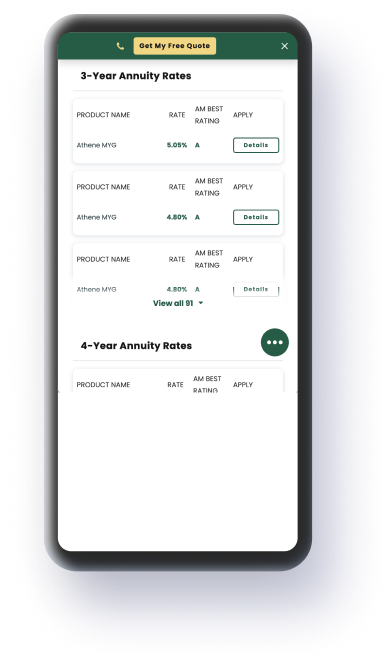An indexed annuity — also known as a fixed index annuity or an equity-indexed annuity — is a long-term savings product whose return is based on a stock market index. Indexed annuities can be tied to major market indexes such as the S&P 500, or to private indexes, depending on the financial institution or insurer who sells them.
Unlike stocks, indexed annuities provide some security against losses if the market falls. Similar to other annuities, they are intended to provide a steady stream of income during retirement and can be used to round out a 60/40 investment portfolio.
But they often fall between stocks and other annuities in terms of complexity and returns. Indexed annuities set limits on gains and losses — offering fewer risks but also potentially lower returns.

Purchase an Annuity Today
Pros of Indexed Annuities
Protection from Loss
Indexed annuities are designed to protect your savings against losses, making them a relatively safe investment.
They’re not tied to the fluctuations of the market and are typically structured so you don’t lose money when the market declines. Instead, they generate a percentage of the profit when the index they’re tied to increases.
Depending on how it’s set up, your indexed annuity can offer some limited protection against risks by establishing a floor or a buffer.
A floor places a percentage limit on how much you’re able to lose — and a minimum on how much you can earn. For example, if the floor is set at 10% and the index decreases by 12%, you would only lose 10% of your contract value.
A buffer, also known as a shield, establishes the loss percentage that the insurance company is willing to absorb before deducting value from the annuity. For example, if the shield is 10% and the index decreases by 12%, you would only lose 2% of your contract value.
Minimum Return Guarantee
The issuing company of your indexed annuity may ensure a minimum return, even in the event that the underlying index loses money. As an example, it might pay 2% even if the underlying index has a negative return.
Offer a Higher Potential Return than CDs
With a chance to participate in the market’s upside, indexed annuities offer potentially higher returns than certificates of deposit (CDs) and come with the added benefit of having the taxes on earned interest deferred, unlike CDs.
“Indexed annuities can work well for conservative savers who want to earn, on average, 1.5 to three percentage points a year more than they would get on bank CDs over a seven- to 10-year period,” said Scott Stolz, president of the insurance and annuity division of securities firm Raymond James Financial Inc., in an article in The Wall Street Journal.

Better Budgeting
Budgeting comes down to knowing how much you’ll have available in your retirement portfolio year after year. Some assets in your portfolio are susceptible to sequence of returns risk — also called sequence risk — which refers to the order in which you receive your retirement savings returns. For example, if early on in your retirement you’re making ongoing withdrawals and the market declines or inflation rises, your portfolio could be negatively impacted or depleted earlier than anticipated.
Since they are intended to prevent against market declines and are set up not to drop below a guaranteed minimum, indexed annuities can help protect you from sequence of returns risk — and help provide peace of mind about the longevity of your portfolio.
Read More: What Is a Fixed Annuity?
Defer Tax Payments
All annuities offer deferred taxes on your earnings so long as you don’t withdraw money from them before the age of 59½. This allows for tax-free growth and increased earning on interest. And it postpones taxes until retirement when they are typically lower than during your working years.
Lifetime Income Option
One of the greatest fears of retirees is outliving their income and savings. By adding a lifetime income rider to your indexed annuity contract, you can guarantee at least 5% and up to 10% per year for the next 10 to 15 years.
The two most common income riders are a guaranteed lifetime withdrawal benefit (GLWB) and a guaranteed minimum income benefit (GMIB). GLWBs guarantee a percentage of your original investment as a payment for the rest of your life — even if the account is depleted early — and can continue to grow even after withdrawals are made. GMIBs also guarantee a minimum income each year, but they stop growing once the account is annuitized.
Ask your advisor about the income rider rate — or the percentage of the annuity that keeps growing — as well as the payout rate — or the percentage you’re guaranteed to receive for the rest of your life — to make sure you’re getting the best deal.
What is an indexed annuity?

Learn how an investment today can provide guaranteed income for life.
Cons of Indexed Annuities
Complex
Because they’re tied to fluctuating market indexes and can have complicated contracts and regulations, indexed annuities can be a complex retirement income option. You’ll likely need to conduct research to ensure you’re getting the best deal.
“Beyond understanding how the return is actually calculated, potential investors need to look at the annual fees the insurance or annuity company charges,” said Coleen Pantalone, associate professor of finance at Northeastern University, in a U.S. News & World Report article. “Investors also need to look at the surrender charges — what happens if you want out of the investment? These are long-term investments, and you are usually penalized by the annuity seller for pulling out early.”
Review the SEC’s Investor Bulletin on indexed annuities to understand your contract’s applicable terms and terminology.
Can Be Unpredictable
Like the stock market they’re attached to, indexed annuities can generate unpredictable returns as they ultimately depend on the performance of a market index. A bad market year — or stretch of years — could earn you potentially less than a more stable or guaranteed retirement option.
Read More: What Is a Fixed Index Annuity?
Non-Liquid
Life happens and, while not desirable, sometimes you need to withdraw money from your retirement savings. While you can withdraw money from your account at any time, you will be taxed and possibly penalized — up to 7% of your withdrawal — for doing so. This is referred to as the surrender charge period, which typically lasts anywhere from six to 10 years — and possibly longer — after your initial purchase. According to the SEC, these charges “will reduce the value and the return of your investment.”
No Investment Dividends
Buying stocks in a range of companies is a great way to diversify your portfolio. Earning equity in a company often generates dividends that you can reinvest and use to boost your retirement savings. While they are tied to a market index, indexed annuities don’t generate dividends the way stocks do — nor are they intended to. Indexed annuities are intended to be a conservative, mostly risk-free way to generate interest.
“An indexed annuity is not an equity investment in any way,” Stolz told The Wall Street Journal. “Anyone who buys it as an equity alternative is going to be disappointed at the results.”
Read More: What Is a Variable Annuity?
Federal Penalties on Withdrawals Before Age 59 ½
As with other types of annuities, indexed annuities are liable to a 10% federal tax penalty if money is withdrawn before age 59 ½. Be sure to check your contract, as some will credit none or only part of the interest accrued if you take out money prior to the end of the term. You may also risk losing some of the principal invested, depending on the value of the market index at the time of the withdrawal.
Alternatives to Indexed Annuities
If you’re not sure if indexed annuities are the right option for you, you could consider alternatives.
- Fixed Annuities
- Insurance products that offer fixed rates of return.
- Variable Annuities
- Insurance products with values based on the performance of underlying investment portfolios.
- Certificates of Deposit
- Savings accounts that offer higher interest rates than traditional savings accounts but restrict access to funds for a set period.
- Bonds
- Debt securities under which an investor lends money to a borrower for a certain amount of time in exchange for interest payments.
- Money Market
- The trade in certificates of deposit, U.S. Treasury securities and other short-term investments.
- Stock Market
- A collection of markets and exchanges where you can buy and sell equities.
- S&P 500
- An index commonly used as a proxy for the U.S. stock market.



